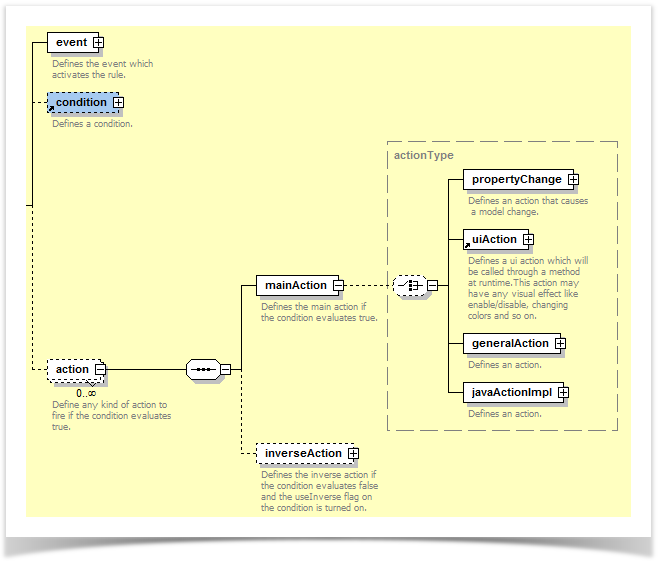An action defines an act implemented when an event occurred and a relevant condition was examined. This action is meant for a firmly determined target, which concerns a single node or multiple nodes. To indicate the target, you need to formulate the XPath expression.
What needs to be defined for each action?
For each action, define:
- Main action (mainAction)
- Reverse action (inverseAction).
Optionally, you may define the reverse action. It is implemented only if the formulated condition has not been met and the condition permits that the reverse action may be implemented (useInverse = true).
XUI schema - Action
Action | Description |
|---|---|
mainAction | Main action, executed with the positive examination of the condition. |
inverseAction | Reverse action (opposite), implemented with the negative examination of the condition.. |
Types of actions
There are three different types of actions:
Type of action | Description |
Property change action (propertyChange) | Sets the formula result to every action target element. The model changes are applied on simple types only. If the XPath addresses a complex node, the action is ignored. |
UI action | Triggers visual actions. That is, it displays (fades in) or hides (fades out) components, color changes and so on. A target is indicated by an XPath statement. The statement refers to a data element and consequently its representation types. Then, the method (methodName) is executed. The definition of the method name is compliant with the Java Beans Definition |
Formula action (generalAction) | Triggers any kind of action. |
| Java action (javaActionImpl) | Calls a java action implementation (must implement Action interface) through java reflection api. Be sure this class implmenents the jaxfront action interface (com.jaxfront.core.rule.Action) |
To set new model values, use a formula expression. With this expression, you can use complex XPath statements or extended functions. In the above example, the new value "my change of model" is set on the target node.
<propertyChange> <formulaExpression>"my change of model"</formulaExpression> </propertyChange>
With an UI-action the method name and the parameters, which will be handed over, are required. In the above example the target element is hidden.
<uiAction methodName="setVisible"> <param name="visible" type="boolean" value="true"/> </uiAction>
Use general action if you which to fire a formula (JEP expression).
<generalAction> <formulaExpression>any alid formula comes here<formulaExpression/> </generalAction>
Use a javaActionImpl in case you want to call your own action implementation.
<javaActionImpl className="com.mypackage.myClass"> <param name="name1" type="String">my String<param/> </javaActionImpl>
The parameters are used to find an according constructor in your action implementation class. In the case above the must be a constructor with on string parameter value:
package com.mypackage
import com.jaxfront.core.rule.Action;
public class MyClass implements Action
public MyClass(String anyString) {
}
}
